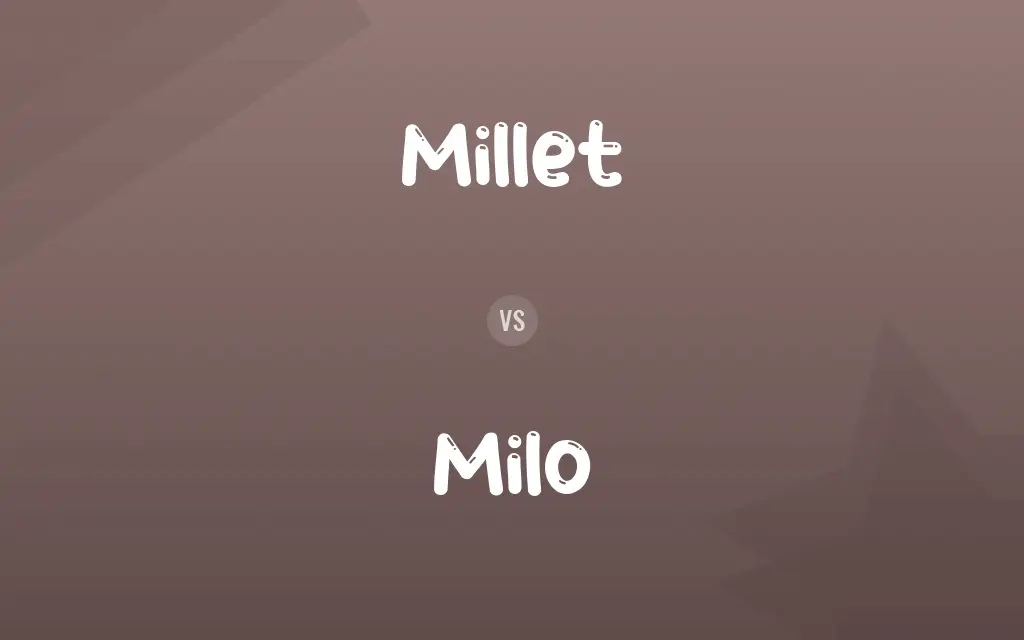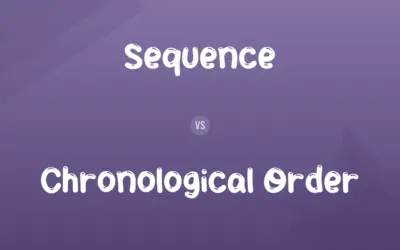Millet vs. Milo: Difference and Comparison
Edited by Muazma Batool — By Muneeza Rehman — Published on April 4, 2024
Millet refers to a group of highly variable small-seeded grasses, widely grown around the world as cereal crops or grains for fodder and human food. Milo, is a specific type of millet known for its drought resistance, used as fodder.

Difference Between Millet and Milo
Millets are a diverse group of small-seeded grains, including varieties like pearl millet, foxtail millet, and finger millet, among others. They are prized for their adaptability to poor soils and harsh growing conditions, including arid and semi-arid regions. Milo, or sorghum, while often classified as a type of millet, stands out due to its particular use in both human consumption and as a livestock feed, as well as its role in sustainable agriculture due to its drought resistance.
Muneeza Rehman
Apr 04, 2024
Nutritionally, millets offer a rich source of protein, dietary fiber, and vitamins, such as niacin, B6, and folic acid, making them a valuable addition to a diet, especially in regions dependent on cereal grains. Milo, specifically, contains higher levels of antioxidants, which contribute to health benefits like reduced inflammation and lower blood sugar levels. This nutritional profile positions milo as a significant crop for both human health and livestock nutrition.
Muneeza Rehman
Apr 04, 2024
Cultivation practices for millets vary widely, depending on the specific type. They generally require less water and can thrive in poor soil conditions compared to other grains, making them an excellent crop for ensuring food security in challenging environments. Milo's cultivation, in particular, highlights the crop's resilience to drought conditions, with deep root systems that enable it to access water from deeper soil layers, further underscoring its importance in drought-prone areas.
Muneeza Rehman
Apr 04, 2024
In terms of culinary uses, millets are versatile grains that can be cooked in a variety of ways, serving as a staple in many traditional dishes across Africa, Asia, and India. They can be boiled, roasted, ground into flour for bread, or popped like popcorn. Milo, when used for human consumption, is often ground into flour for baking, used in brewing beer, or made into porridge, showcasing its versatility beyond just animal feed or syrup production.
Henry
Apr 04, 2024
The global significance of millets, including milo, is on the rise, not only due to their nutritional benefits but also because of their role in sustainable agriculture. As the world faces increasing environmental challenges, crops like millets that require fewer inputs and are more resilient to climate change are becoming increasingly important for food security and agricultural sustainability.
Nolan
Apr 04, 2024
Millet vs. Milo Comparison Chart
Definition
A group of small-seeded grasses, used as cereal crops or grains.
A specific type of millet, known for its drought resistance.
Muneeza Rehman
Apr 04, 2024
Types
Includes pearl, foxtail, finger millets, etc.
Primarily refers to sorghum varieties.
Muneeza Rehman
Apr 04, 2024
Nutritional Profile
High in protein, fiber, and vitamins.
Similar, but with higher antioxidant levels.
Muneeza Rehman
Apr 04, 2024
Cultivation
Adaptable to poor soils, requires less water.
Especially drought-resistant with deep root systems.
Leo
Apr 04, 2024
Culinary Uses
Versatile, used in traditional dishes, flour, and snacks.
Used in flour, beer brewing, porridge, and syrup production.
Nolan
Apr 04, 2024
Millet vs. Milo Definitions
◉Millet
Millets are nutritious, offering benefits from protein to dietary fiber.
Finger millet flour is excellent for baking nutritious bread.
Henry
Feb 21, 2024
◉Milo
Milo, or sorghum, is a millet variety known for its robustness in dry conditions.
Our milo crop survived the drought with minimal irrigation.
Kaitlyn
Feb 21, 2024
◉Millet
It's a versatile food source, used in diverse culinary applications.
I made a hearty stew using foxtail millet as a base.
Muneeza Rehman
Feb 21, 2024
◉Milo
It serves as both a food and fodder crop, versatile in use.
We feed milo to livestock and use it to make syrup.
Olivia
Feb 21, 2024
◉Millet
Millet encompasses various grains known for their resilience to harsh growing conditions.
Pearl millet has become a staple in our diet due to its drought tolerance.
Muneeza Rehman
Feb 21, 2024
◉Milo
Its deep root system makes it exceptionally drought-resistant.
Milo's roots reach deep into the soil, accessing water other crops cannot.
Jonathan
Feb 21, 2024
◉Millet
Cultivation requires minimal water compared to other grains.
We planted millet this season because it thrives with less rain.
Muneeza Rehman
Feb 21, 2024
◉Milo
Beyond fodder, it's used in making gluten-free flour and beer.
I brewed a batch of beer using malted milo for a unique flavor.
Muneeza Rehman
Feb 21, 2024
◉Millet
They play a crucial role in food security across semi-arid regions.
In arid regions, farmers rely on millet as a staple crop.
Leo
Feb 21, 2024
◉Milo
High in antioxidants, milo offers significant health benefits.
Milo grain is a healthy choice due to its antioxidant content.
Muneeza Rehman
Feb 21, 2024
◉Millet
Any of various annual grasses with small grains that are harvested for food, livestock feed, and birdseed, especially proso millet.
Muneeza Rehman
Feb 20, 2024
◉Milo
Any of various sorghums that are cultivated for their grain, which resembles millet. Also called grain sorghum.
Muneeza Rehman
Feb 20, 2024
◉Milo
Small drought-resistant sorghums having large yellow or whitish grains
Muneeza Rehman
Feb 20, 2024
Millet vs. Milo Frequently Asked Questions
How does the nutritional value of milo compare to other grains?
Milo is nutritionally rich, offering high levels of antioxidants, proteins, and dietary fiber, often surpassing common grains like wheat and rice in certain nutrients.
Muneeza Rehman
Apr 04, 2024
Why is millet considered important for sustainable agriculture?
Millet requires fewer inputs such as water and fertilizers, is adaptable to poor soils, and has a resilience to climate change, making it crucial for sustainable agriculture and food security.
Muneeza Rehman
Apr 04, 2024
Can milo be used in a gluten-free diet?
Yes, milo (sorghum) is gluten-free and can be ground into flour for baking, making it suitable for gluten-free diets.
Muneeza Rehman
Apr 04, 2024
What distinguishes milo from other types of millet?
Milo, or sorghum, is distinguished by its exceptional drought resistance, nutritional profile rich in antioxidants, and versatile uses, including syrup production, not commonly associated with other millets.
Muneeza Rehman
Apr 04, 2024
Are there any environmental benefits to cultivating milo?
Yes, cultivating milo contributes to environmental sustainability by requiring less water, tolerating high temperatures, and improving soil health through its deep rooting system, making it an eco-friendly crop choice.
Kaitlyn
Apr 04, 2024
Is there a difference in taste between milo and other millets?
Yes, milo (sorghum) tends to have a slightly sweeter and nuttier flavor compared to other millets, which can vary in taste from mild to earthy, depending on the variety.
Muneeza Rehman
Apr 04, 2024
Can milo be eaten raw?
Milo (sorghum) grains are hard and not typically eaten raw; they are usually cooked, popped, or ground into flour for consumption.
Leo
Apr 04, 2024
What types of dishes can be made with millet?
Millet can be used in a variety of dishes, including porridges, salads, breads, and even desserts. It's also popularly popped like popcorn in some cultures.
Henry
Apr 04, 2024
How do milo and millet contribute to dietary diversity?
Both milo and millet offer a gluten-free alternative to common grains, enriching dietary diversity with their unique flavors, textures, and nutritional benefits.
Muneeza Rehman
Apr 04, 2024
What is the best climate for growing millet?
Millet thrives in warm climates and is particularly suited for arid and semi-arid regions where other crops might fail due to lack of water.
Muneeza Rehman
Apr 04, 2024
Content Creators
Written by
Muneeza RehmanAt Comparisons.wiki, Muneeza skillfully navigates the vast sea of information, ensuring clarity and accuracy as the lead content editor. With a keen eye for detail, she curates every comparison to enlighten and engage readers.
Edited by
Muazma BatoolAs a content editor, Muazma Batool is not just a grammar guru but a creative mastermind who breathes life into every word. With an eagle eye for detail and a passion for storytelling, she transforms bland text into engaging content that captivates audiences and drives results.

































